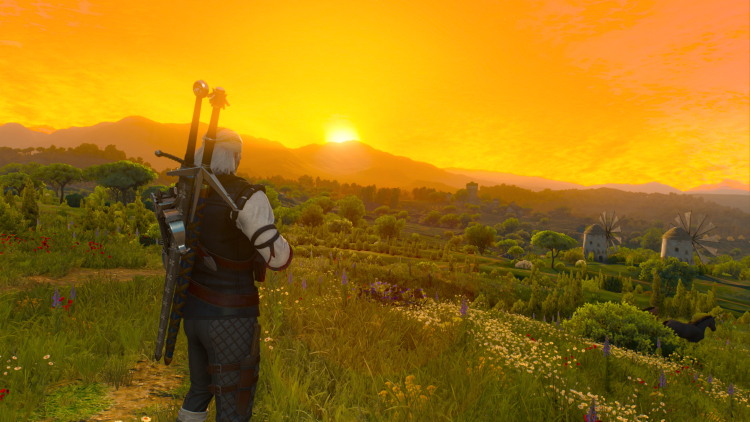Digital Windows: YouTube's Ambiance Video Phenomenon

A croak among the cicadas and a golden-age ship floats in over the still of a fogged lake. Somewhere from behind are faint voices and commands, organizing and passing time. The sky is dark blue, stars dot it, and gray streaks remember the coming and going of slow traffic.
The scene is from "Destiny 2 Ambiance - The Farm, Earth," uploaded by the YouTube channel OrbitUknown. The video only has 1,300 views and lingers in a population of unpopulated videos, found only with a specific search in the search bar. It’s just one of thousands, if not millions of examples of ambiance videos centered around the digital spaces and environments in video games, a subgenre of ambiance videos that already possess a large stake in YouTube’s population.
YouTube is a platform worthy of debate on its own, being the second most visited website on the internet behind Google and operating as an active library for video sharing. As of 2023, YouTube has over 2.3 billion active users who consume about 1 billion hours of YouTube every day.
But where does all that traffic go?
Most of YouTube’s activity today is shared between music videos, how-to videos and videos from influencers, but Autonomous Sensory Meridian Response or ASMR content also captures quite a large portion of that activity. ASMR on YouTube mainly consists of videos designed around aesthetic and pleasing sounds. It’s an attempt to instill that oddly satisfying feeling so many of us are familiar with but have a hard time describing, the light skim of a finger on the skin that makes hair stand straight and goosebumps rigid. And rising within the larger ASMR genre are ambiance videos, of a similar philosophy but focused less on stimulation and more on establishing a calm space.
“When I miss the sound of mourning doves and the woods near my house, I can trick my brain, even if just a little, into calming that feeling of homesickness. We can't always pick our location or the weather or whatever we are missing, but we can at least give ourselves something that alludes to it to quell that feeling of longing,” says Mars McCameron, a student at AUP. McCameron talks about spending a lot of time in Korea, and when missing it, going to HelloKorea on YouTube and listening to the soundscapes of different cities, “If I close my eyes, I can almost feel like I’m back.”
Video game ambiance specifically can take on a few different forms. In one version, soundtracks take the main stage, and similar to YouTube’s legendary LoFi Girl, with “beats to relax/study to,” these are often videos with lightly animated or static backgrounds with a compilation of the game’s music playing. In another format, visual elements have increased participation, the camera is fixed at one or several points in the game, usually places players go when playing the game, and either the ambient noises, the soundtrack or both accompany the static shot. The duration of such videos can be anywhere as short as 30 seconds to 15 hours, and since the recordings are of designed, almost living worlds, things like the lighting, time of day, objects, people or animals will move organically over time throughout those spaces.
Gamescapes is one channel known for uploading videos of different regions of the environment from The Legend of Zelda: Breath of The Wild. It's relatively small, with around 9,500 subscribers, but there’s something heartfelt about the tighter community, about a quaint little library of sorts archiving such even-tempered spaces. AJ, the name behind the channel, started making ambiance videos in 2018, after repeatedly keeping her Nintendo Switch running on the TV for background noise. AJ says, “I spent a lot of time setting up screenshots like I was a landscape photographer. Eventually I recorded and uploaded scenery videos of shots I liked so that I could have them looping in a playlist on my second monitor while I was working from home. It was like having a window into one of my favorite game worlds.”
On a bigger scale, Everness, a channel that uploads a lot of videos from World of Warcraft and Skyrim, has quite a substantial subscriber base of around 211,000. Everness’ videos are sometimes static and sometimes pan through the games’ environments, with the soundtracks and ambient noises of each respective title for sound. "Skyrim - Music & Ambiance - Night," an hour of different fixed shots composed in the format mentioned is the channel’s most popular video with 18 million views.
Video games have a dominant presence in our culture today, and it's not unwarranted to imagine game ambiance videos on YouTube in the same light as the photo albums on our phones and computers. Still, the format of such videos poses interesting questions. In the case of "Destiny 2 Ambiance - The Farm, Earth" the digital space being recorded no longer exists in the video game—removed as a result of the continuous updates Destiny 2 has received over the years. An issue of materiality then arises: Where are these digital spaces really, and what are they, if not artful renditions viewed through fixed and interactive lenses? And like the first motion pictures, where is the separation between representation and subject, especially if that subject no longer exists, or was a representation itself to begin with?







